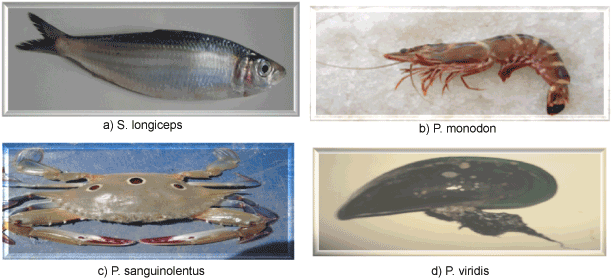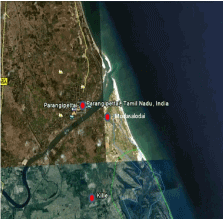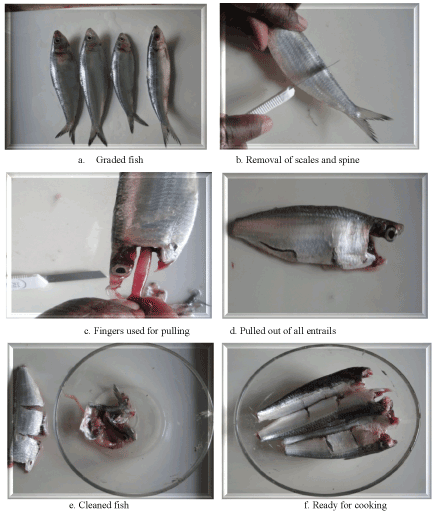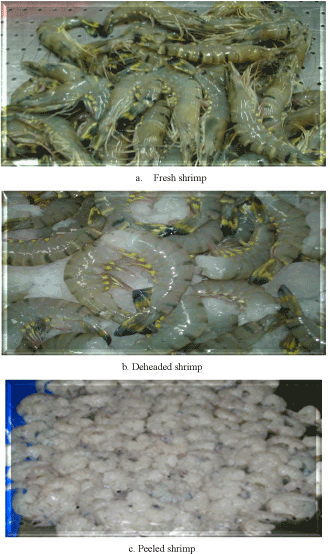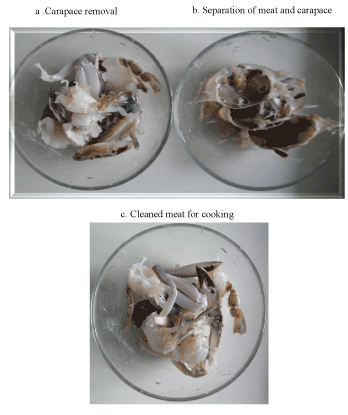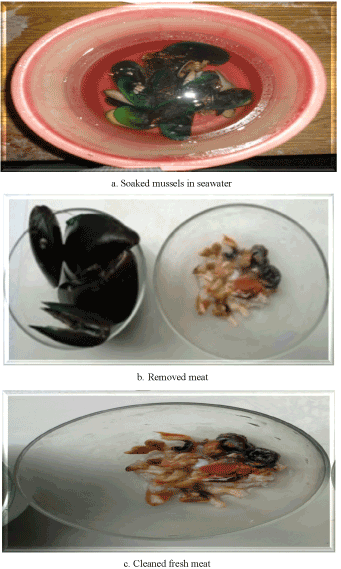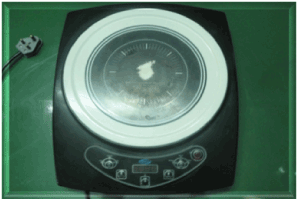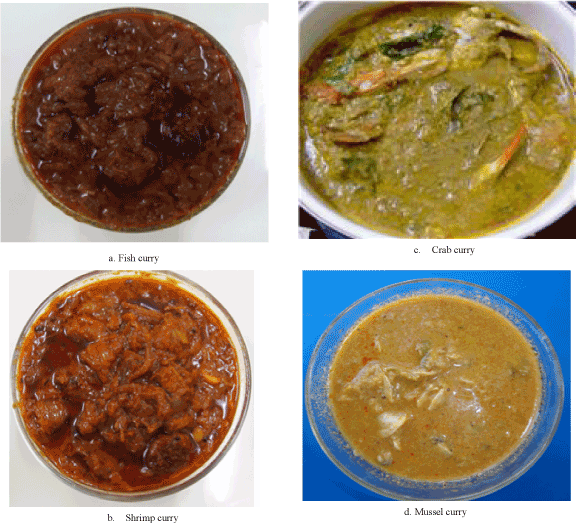| Research Article |
Open Access |
|
| Pushparajan N1*, Soundarapandian P1 and Varadharajan D1 |
| 1Centre of Advanced Study in Marine Biology, Annamalai University, Parangipettai-608 502, Tamil Nadu, India |
| *Corresponding authors: |
N. Pushparajan
Faculty of Marine Sciences
Centre of Advanced Study in Marine Biology
Annamalai University, Parangipettai-608 502
Tamil Nadu, India
E-mail: natanapushpan@gmail.com |
|
| |
| Received May 09, 2012; Published July 28, 2012 |
| |
| Citation: Pushparajan N, Soundarapandian P, Varadharajan D (2012) Recipies Preparation of Some Commonly Available Fish and Shellfishes. 1: 190. doi:10.4172/scientificreports.190 |
| |
| Copyright: © 2012 Pushparajan N. This is an open-access article distributed under the terms of the Creative Commons Attribution License, which permits unrestricted use, distribution, and reproduction in any medium, provided the original author and source are credited. |
| |
| Abstract |
| |
| Even though seafood is nutritious but taste is important to attract the consumers. So preparation of food with taste is very much essential to encourage the customers of local and overseas. So the present study it is aimed to prepare different recipes from fish and shellfishes. The organoleptic tasting of the fish curries (Fish, shrimp, crab and mussel) were prepared following standard methods. The suitability of the food items prepared in the present study was evaluated using standard testing condition. The quality of the food was evaluated by a combination of factors, which includes the appearance (size, shape and colour) texture (kinestheticks) and flavour (smell and taste). Hidonic taste was carried out on the basis of 5 points scale (5-Excellent, 4- Good, 3-Aaverage, 2- Fair and 1- poor). A panel of 8 persons consisting of nontrained researchers evaluated the sensory quality of the product. Each product, 2 cans (fish, prawn, crab and mussel) totally 8 cans was used for sensory and texture analysis. The sensory attributes evaluated were colour, firmness, succulence, chewiness and overall acceptability using a 9 point hedonic scale. A score above 6.0 was considered as the margin for acceptance. The panel pointed out that dishes were as good as those made out of the much sought after seafood in taste, smell and flavours. |
| |
| Keywords |
| |
| Fish; Shrimp; Crab; Mussel; Recipies |
| |
| Introduction |
| |
| Fish and fish products attracted food technologists for their marvelous potential and health benefits leads to development of varieties of foods [1,2]. Fish is an excellent source of protein and rich in vitamins and minerals [3]. The eating habits of a lifetime can have a great effect on an older person. Many health problems common among older people are related to lifelong diet patterns. These includes heart disease, diabetes, stroke, high blood pressure, osteoporosis (thinning bones), atherosclerosis (fatty deposits in blood vessels), and digestive problems. Good nutrition is important to care of ill and frail persons. It speeds up healing, recovery from illness, and helps to maintain health. |
| |
| Seafood represents an excellent option as a major source of nutrients especially when used in combination with other muscle foods [2]. Fish provides a good balance of protein, vitamins, minerals and a relatively low calorific content. Fish constitutes a highly perishable group of foods [4]. In addition the PUFA content, especially the n-3 and n-6 PUFA have been considered as essential fatty acids and have been shown to have curative and preventive effects on cardiovascular diseases, neurodevelopment in infants, cancer and fat glycemic control [5]. |
| |
| Fish deteriorates after death due to the action of different factors that can be summarised as microbiological, enzymatic and oxidative etc. Among the various factors leading to fish spoilage, bacterial activity is the most important factor that produces the most striking and undesirable alterations in the flavour, odour and appearance [6]. Due to the high perishable nature of fish, various preservation methods like drying, curing, canning, freezing etc have evolved over the period of time. Although each have their own advantages and disadvantages, these food preservation methods are aimed at preventing undesirable changes in the wholesomeness, nutritive value and sensory quality of food by controlling growth of microorganisms and obviating contamination by adopting economic methods. |
| |
| Early in history, humans discovered that food would remain edible longer if it were dried and stored in a cool dry place until it was time to be consumed. Early food dehydration was achieved by cutting fish, meat, and certain fruits into thin strips and drying them in sunlight. Rubbing food with salt or soaking it in salt water, an early form of curing food also helped to preserve it. Later techniques were developed for cooking, processing, preserving and storing cooked food in sealed containers. The thermal processing food method involving the application of heat, the extent of which varies with the specific objectives and accordingly the thermal processing is classified into blanching, cooking, pasteurization, cooking and sterilization. Incontainer sterilization is the most common method of heat treatment. It involves application of heat that is sufficient to destroy microbes that can cause spoilage or disease and the enzymes. The hermetic seal maintains an environment in the container that prevents the growth of other microbes of higher resistance and most importantly, prevents recontamination and pathogens from producing toxins during storage [7]. |
| |
| Seafood scenario is witnessing a vast change. The world over present market trends are indicative of extensive of growth in demand for readyto- eat serve ‘convenience’ product processed out of a variety of fish and shellfishes. Increasing in member of working woman, awareness of the different type of convenience products, and overall improvement in standard of living has contributed to this change. Value addition and diversification of products have been identified as the need of the day. Technology upgradation and value addition has been instrumental in processing several shellfish products and successfully marketing them in overseas countries and in urban domestic markets. In all its forms of application, thermal processing persists as the most widely used method of preserving and extending the useful shelf life of foods. With the growth of towns, the need to preserve foods longer increased as some people could no longer grow their own vegetables nor keep animals. With the developments of pasteurization and canning, a much larger variety of foods could be stored and carried on long journeys. |
| |
| More recently, refrigeration and quick-freezing have been used to help preserve food flavour and nutrients and prevent spoilage. Spoilage of fish takes place basically due to three reasons- microbial, enzyme and chemical. The principal among these is spoilage caused by the action of microorganisms. The basic method of preservation of fish which are commercially employed including lowering the temperature, application of high temperature treatments, control of moisture by different methods, addition of natural preservatives like salt or other chemicals, fermentation, smoking, irradiation etc. Essentially, food that has been washed and prepared is sealed in a tin-coated steel can. Canning involves heating fish to destroy the spoilage organisms present in them and elimination of the possibility of post-process reinjection by enclosing it in a container and hermetically sealing it before subjecting to heating. The can is then subjected to heat to raise the temperature to a predetermined level for a set period to kill food spoilage organisms. Chemical preservatives are not needed in the food canning process. Because foods stay sealed in the steel can, outside contamination is prevented and the food remains sterile until the can is opened. |
| |
| Worldwide, the total for food packaging is approximately 80, 000 million cans. Surprisingly, in 58 developing countries; more than 20% of animal protein supply came from fish [8]. It implied that there must be thousands of recipes prepared from fishes available around the world. Micronutrients in fish are renowned, however, with different quantities depending on the type of fishes. For example, cod, a white meat fish, contains 60 mg sodium, 9 mg calcium and 0.1mg iron, whereas 123 mg, 60 mg and 1.2 mg, respectively, were found in herring, which determined from 100 g raw edible portion [8].Seafood is more perishable, compared with other muscle foods such as beef, pork, chicken, etc. For this reason it requires more careful handling and storage. Most commercially harvested fishery products are landed at ports which removed from the point of harvest. Poor handling practices on board ships and on shore can cause deterioration in fish and shellfish quality before it is sold to the consumer [9]. In the present study recipes were prepared from the commonly available fish and shellfishes by using standard methodology. |
| |
| Description of the Collection Area |
| |
| The specimens, Sardinella longiceps, Penaeus monodon, and Portunus saguinolentus (Figure 1a-1c) were collected from Parangipettai, Mudasalodai and Killai fish landing centers (Lat.11°29’N Long. 79°46’ E). These landing centers are one among the potential fishing zone of Tamilnadu, South coast of India. Parangipettai, Mudasalodai and Killai coastal water comprise three important biotopes viz. Vellar estuary, Killai backwater and Pitchavaram mangroves which play a vital role in supporting the commercial fisheries, since many of them use those biotopes as nursery grounds. The Vellar estuary river, originating from Shervaryan hills of Salem district of Tamilnadu meanders over a distance of approximately 480 km and form the estuary complex at Parangipettai. The Vellar estuary has an intricate system of rivers, channels, Killai backwater, Pichavaram mangroves and near shore water. The fish and shellfishes landed daily are marketed locally and in the surrounding villages. Choice items are moves in interior places and are also exported. As many as 439 species of fishes belonging to 120 families have been reported [10]. Among these 100 species have commercial value and as many as are consumed directly. |
| |
|
|
Figure 1: Specimens used for recipies preparation |
|
| |
| The green mussel Perna viridis (Figure 1d) was collected from the Parangipettai station. Bunches of mussels were found attached to the artificial rocks near old jetty. This location is opposite to the marine biological station which is approximately 2 km away from the seashore, upstream. The average depth of the collection site is 1.5 m during low tide (Map 1). |
| |
|
|
| |
| Materials and Methods |
| |
| Meat preparation |
| |
| Fish (S. longiceps): Fresh specimen of S. longiceps (Figure 1a) was purchased from the landing center. Once reaching to the laboratory they were graded according to the size and quality. After selection they were thoroughly washed to remove the mud, dirt etc. Dressed the fish by cutting the head, ribs to both sides of the spine. The entrails were pulled out without slitting the belly. Fingers were used to pulling out of the flesh. The fish was washed in running water and cut down the fish according to can size. The spine was brought out with very little flesh attached. The bones were pulled out by using fingers and care was taken to prevent the tear of flash. |
| |
| The fish pieces were immersed in blanching brine (15% NaCl) for 10 min and quickly rinsed in freshwater (Figure 2a-2f).Then weigh the material required for packing in each can and the fish was packed neatly. They were placed in a cooker or retort and were cooked for 30 min. at 100°C in stream (precooking) and drain the exudates that comes off the fish during precooking. Than the can was filled with curry mixture leaving a head space 10mm and adjust the weight to the standard net weight. |
| |
|
|
Figure 2: Cleaning process of Fish |
|
| |
| Shrimp (P.monodon): The fresh shrimps (Figure 1b) were purchased from the landing centre and brought to the laboratory. After reaching the laboratory they were thoroughly washed with water to remove the foreign particles. After taking the weight they were beheaded and peeled (Figure 3a-3c) then the shrimps were gently cutting through the dorsal side and removing the intestine with the help of a sharp knife. Devein the peeled shrimps after blanch and it was dried (under fan for about 20-30 min) in required quantity and freeze them if canning was not done immediately. The deveined shrimps were washed in chilled water and weigh them required for packing. Blanch the shrimp meat in boiling brine (containing 6% NaCl and 0.2% citric acid for 6min). The blanching operation was done carefully avoid further contamination and to get uniform quality product. |
| |
|
|
Figure 3: Cleaning process of Shrimp |
|
| |
| Finally grading was done for size designation and packed in thoroughly cleaned cans and filled. In curry pack, the shrimp was packed as such followed by adding curry and mixed in 60:40 propositions and packed in the can. The packed materials was sealed using double seamer. |
| |
| Crab (P. sanguinolentus): The specimens of P. sanguinolentus were purchased from the landing center. They were used either live or very fresh condition. The live specimens were placed in freshwater to paralyze and finally kept in ice until further use. |
| |
| The crab was washed with freshwater thoroughly and weight was taken. Then the carapace was removed and pulls apart from the body. The gills and viscera were removed and wash the carcasses in running water. Then weight was taken required for packing and blanching both body and legs in hot brine containing 2% NaCl for 15 minutes and cools them by keeping in ice. Subsequently the meat was separated by using knife /scissors and care was taken to avoid wastage of flash. Claw meat and body meat was placed separately. Weighed meats were calculated for further preparation. They were arranged in a retort to avoid the microbes and cooked the claw and body meats for 30 min at 100°C in stream (precooking) and drained the exudates that comes off from the crab during precooking (Figure 4a-c). |
| |
|
|
Figure 4: Cleaning process of crab |
|
| |
| Mussel (P. viridis): After collection, mussels were brought to the laboratory in plastic buckets with seawater. The mussels were thoroughly washed in potable chlorinated water to a level of 5 ppm and allowed over night to remove faecal waste, epifauna and epiflora. Scrub the mussels as much as possible by changing the water several times, scrape off the beards, and rinse the mussels. Soak the mussels in just enough cold water to cover for several hours or overnight to disgorge any sand or soak the mussels in cold water sprinkled with a handful of corn meal for 1 hour. The mussel was drained and rinses under running cold water. The mussels were arranged in one layer in a baking pan and put the pan in a preheated hot oven (450°F.) for 7 to 8 min or until the shells were opened. Unopened shells were discarded. The removed meat was cleaned free from guts, washed and thoroughly drained. Meat was kept separately (Figure 5a-5c).Then final grading was done for size designation. Pack the size graded mussels in well cleaned cans and fill appropriately. In curry pack, the mussel gravy may either be packed as such followed by adding curry or alternatively the mussels and curry are mixed in 60:40 propositions and packed in the can. |
| |
|
|
Figure 5: Cleaning process of mussel |
|
| |
| Curry preparation |
| |
| The oil was heated (Figure 6) and all ingredients were fried one by one until golden brown appeared (mustard, cumin, sliced onion, tomato’s, chilies, garlic and ginger past except the turmeric and chilli powder) then ground them to get fine paste. In the same kadai, turmeric extract was poured and mixed with fish masala powder and salt and again stirred well. The entire mixture was allowed to boil for sometime in low flame until gravy became thickness. Few fried curry leaves were added to get tasty gravy. Similarly other curries were prepared but little bit modification in the ingredients. (Tables 1-4) (Figure 7a-d). |
| |
|
|
Figure 6: Induction stove |
|
| |
|
|
Table 1: Ingredients used for fish curry preparation |
|
| |
|
|
Table 2: Ingredients used for shrimp curry preparation |
|
| |
|
|
Table 3: Ingredients used for crab curry preparation |
|
| |
|
|
Table 4: Ingredients used for mussel curry preparation |
|
| |
|
|
| |
| Can filling |
| |
| The processed material was weighed for packing in each can (240 g for 300×409 cans) and finely the fish was packed neatly followed flower pack style (depends on fish) by arranging the fish pieces with belly facing the center alternatively with head and tail region facing down and dorsal side touching the inner walls of the can. Than the can is filled with curry mixture leaving a head space 10 mm and adjust the weight to the standard net weight. |
| |
| They were placed them in a retort or Overpressure autoclave (John Fraser Ltd, Model 24 Rotary Pilot Scale) and the fish was cooked for 20 min. at 100°C in stream (precooking) and drain the exudates that comes off the fish during precooking. Then the can was filled with curry mixture leaving a head space 10 mm and adjust the weight to the stranded net weight. Then exhausted the cans in stream cooker for 10 min and then sealed the cans with double seamer. Again the can was washed the exterior and load them in for heat processing, after heat processing release the stream pressure gradually and cool them in chlorinated water. The can was finish labeled and store them in dry place. |
| |
| Results and Discussion |
| |
| The organoleptic tasting of the fish curries (Fish, shrimp, crab and mussel) were prepared following standard methods. The appearance of the various dishes was no doubt appetizing. The food has a uniform nature colour. It was neither too pale nor intense. The flavour and odour of the various fish curries of the present study is almost similar those to prepared earlier [11-13]. |
| |
| The suitability of the food items prepared (fish, prawn, crab and mussel meat) in the present study was evaluated using standard testing condition as described by [14]. Organoleptic testing, which has been the traditional method of determining the seasonary qualities of a food, was employed in this method, an untrained taster also can evaluate the food by simply looking, tasting, smelling and touching it. The quality of the food was evaluated by a combination of factors, which includes the appearance (size, shape and colour) texture (kinestheticks) and flavour (smell and taste). Hidonic taste was carried out on the basis of 5 points scale (5-Excellent, 4- Good, 3-Average, 2- Fair and 1- poor). A score card was prepared for this purpose. |
| |
| The score card was neat and has a place for the name of the scorer, the date and code number of the products. Confutation from using the same number again was avoided by numbering the products consecutively. The numerical scale to score numerically the palatability factor of the food products was clearly stated along with the descriptive team that accompanies the gradation. The score care was also explained to the panel. The following point was considered for the proper evaluation of the dishes. |
| |
| |
| 1. The sample for scoring was presented in an attractive manner. |
| |
| 2. Dishes of sample shape and colour were used. |
| |
| 3. Each dish was provided with the code number of the product. |
| |
| 4. The score was not rushed, annoyed, irritated or interrupted after he/she started scoring. |
| |
| 5. The scorer was comfortably seated and not interrupted during the scoring process. |
| |
| 6. Proper and other products that may give the food an off flavor were avoided. |
| |
| 7. Neutralizing agent, water was given in between sample. |
| |
| Finally, the result of score card was consolidated and reproduced. |
| |
| A panel of 8 persons consisting of nontrained researchers evaluated the sensory quality of the product. Each product, 2 cans (fish, prawn, crab and mussel) totally 8 cans was used for sensory and texture analysis. The sensory attributes evaluated were colour, firmness, succulence, chewiness and overall acceptability using a 9 point hedonic scale. The sample was served after heating in a microwave oven for 3 min on a coded plate. Water was provided to restore taste sensitivity. Panellists were asked to assign a score of 1 to 9 (Table 5) as prescribed by [15]. A score above 6.0 was considered as the margin for acceptance. |
| |
|
|
Table 5: Panellists score card |
|
| |
| The first appraisal of a food is by sight and the colour, the shape, the size and the surface all register impressions. Part of the acceptance of a food depends on how it looks. Thus the appearance of a food is the most important factor in its evaluation. The colour was neither too pale nor too intense and has a uniform natural colour. If the colour was closely identified with the weight acceptable qualities of the dishes prepared with help of previous work [16]. The appearance of the food is another important factor in its evaluation. Since the dishes looked appetizing, they were immediately accepted. Texture is the most important factor regarding shrimp sensory quality as it exhibits dramatic changes during extended thermal processing [17].The texture of a food feels in the mouth, and Kinesthitic sensations are the power of resistance feelings of motion in the underlying blood vessels, bones, muscles and tendons when they are stimulated. |
| |
| Flavor is the total sensory impression formed when food is eaten. It is among the most important factors motivating food choices. Flavour impressions gained when food is eaten, are a combination of the sensations of fast, smell and mouth feel. The flavours of the fish, shrimp, crab and mussel curries are very much similar and hence removed all the inhibitions in the minds of the penal members. |
| |
| Acceptance or rejection of food is based largely on the stimulus of the sense organs of the individual. The sensory attributes of food are major factors that influence food consumption [14]. Shahidi F [18] described sensory quality of shrimp as a complex set of characteristics including appearance, aroma, taste and texture. Food is evaluated by the senses of sight, smell, taste, touch and hearing. These senses of sight, smell, taste, touch and hearing help to determine whether a food is accepted or rejected. If the food is perceived to be attractive, mouth wanting and with a delicious aroma, the food will be accepted [14]. |
| |
| The penal of judges vouched safe for taste and delicacy of the dishes. The panel pointed out that dishes were as good as those made out of the much sought after seafood in taste, smell and flavours. This same appearance, texture, flavour, taste and smell were maintained for further preparation of canned food curry preparation. |
| |
| |
| References |
| |
- Kinsella JE (1986) Food component with potential benefits: the n-3 polyunsaturated fatty acids of fish oils. Food Technol 40: 89-97.
- Kinsella JE (1988) Fish and Seafoods: Nutritional implications and quality issues. Food Technol 146-150.
- Guthrie HA (1983) Introductory Nutrition (6th edn). Mosby Publishers, Missouri.
- Cheftel J, Cheftel H (1976) Introduccion a la bioquinica y technologia de alimentos. Vol. 1. Zaragora Spain: Acribia.
- Connor WE (1997) The beneficial effects of omega-3 fatty acids: cardiovascular diseases and neurodevelopment. Curr Opin Lipidol 8: 1-3.
- Reay GA, Shewan JM (1949) The spoilage of fish and its preservation by chilling. Adv food Res 2: 343-398.
- Awuah GB, Ramaswamy HS, Economides A (2007) Thermal processing and quality: principles and overview. Chem Eng Process 46: 584-602.
- Holland B, Brown J, Buss DH (1993) Fish and fish products. In: The composition of foods (5th edn), Mc Cance RA and Widdowson EM (eds). Te Royal society of chemistry and ministry of Agriculture, Fisheries and food.
- Ashie IN, Smith JP, Simpson BK (1996) Spoilage and shelf-life extension of fresh fish and shellfish. Crit Rev Food Sci Nutr 36: 87-121.
- Ramaiyan V, Senthilkumar R (1997) Laboratory manual on fisheries science (Series I). Centre of advanced study in Marine Biology, Annamalai University, India.
- Srinivasa Gopal TK, Vijayan PK, Balachandran KK, Madhavan P, Iyer TSG (2001) Traditional Kerala style fish curry in indigenous retort pouch. Food Control 12: 523-527.
- Sreenath P, Martin Xavier KA, Ravishankar CN, Bindu J, Srinivasa Gopal TK (2007) Standardisation of process parametres for ready-to-eat squid masala in indigenous polymer-coated tin-free steel cans. Int J Food Sci Technol 42: 148-1155.
- Bindu J, Ravishanker CN, Dinesh K, Mallick AK, Gopal TKS (2011) Heat penetration characteristics and shelf life of Ready to serve mahseer curry in opaque. Fish Technol 48: 141-148.
- Freeland-Graves, Gladys Peckham C (1987) Foundations of Food Preparation (5th Edn). Macmillan, London.
- Meilgaard M, Civille GV, Carr BT (1999) Sensory evaluation techniques (3rd Edn). CRC Press, Florida.
- Oz F, Kaban G, Kaya M (2007) Effects of cooking methods on the formation of heterocyclic aromatic amines of two different species of trout. Food Chem 104: 67-72.
- Ma LY, Deng JC, Ahmed EM, Adams JP (1983) Canned shrimp texture as a function of its heat history. J Food Sci 48: 360-363.
- Shahidi F, Botta RJ (1994) Seafood: chemistry, processing technology and quality. Blackie, London.
|
| |
| |

